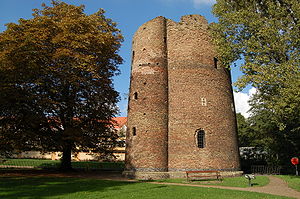Cow Tower, Norwich
| Cow Tower | |
|---|---|
| Norwich, Norfolk | |

Cow Tower, showing the main tower and the stairwell turret (left)
|
|
| Coordinates | 52°38′03″N 1°18′30″E / 52.63419°N 1.30827°E |
| Type | Artillery tower |
| Site information | |
| Controlled by | English Heritage and Norwich City Council |
| Site history | |
| Built | 1398–1399 |
| Materials | Flint and brick |
| Events | Kett's Rebellion |
The Cow Tower is an artillery tower by the River Wensum in Norwich, Norfolk, England. Built between 1398 and 1399 by the city authorities in response to the threat from France and indigenous English rebels, the tower was intended to defend the north-eastern approach to Norwich with hand cannons and bombards. It stood apart from the main city walls, close to the river where its height would have allowed it to fire onto the higher ground opposite the city. The tower was designed to hold a garrison when required and was well furnished, probably using different floors for dining and sleeping.
It was maintained throughout the 15th century, and played a role in Kett's Rebellion of 1549, when the rebels attacked Norwich, deploying artillery and damaging the tower's parapets. Repairs to the tower's walls in the late 19th century inadvertently caused long-term damage, and in 1953 it was taken into the guardianship of the Ministry of Works, who stabilised its condition in a five-year conservation project. In the 21st century, Cow Tower is managed by English Heritage and Norwich City Council; the tower is now only a shell, however, as the floors and the roof of the building have been lost.
The circular tower is 11.2 metres (37 ft) across, 14.6 metres (48 ft) high and divided into three storeys. Its walls are 1.8 metres (5 ft 11 in) thick at the base, with a core of flint stone, faced on the inside and outside with brick; the archaeologist T. P. Smith considers it to feature some "of the finest medieval brickwork" in England. The walls have gunports for the smaller pieces of artillery and the roof would have supported the heavier bombards, with wide embrasures giving the weapons adequate firing space. The Cow Tower was specially designed to support the use of gunpowder artillery, making it a very rare structure in England for this period: the only close equivalents are God's House Tower in Southampton, and the West Gate at Canterbury.
...
Wikipedia

